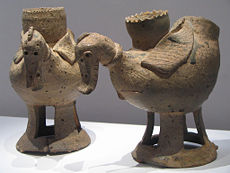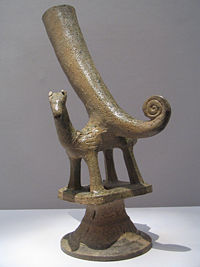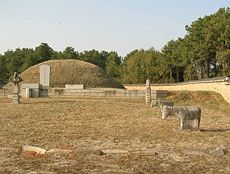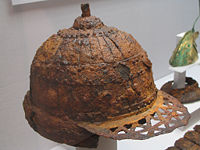Difference between revisions of "Gaya confederacy" - New World Encyclopedia
Dan Davies (talk | contribs) (submitted and approved) |
({{Paid}}) |
||
| Line 1: | Line 1: | ||
| − | {{approved}}{{submitted}}{{images OK}}{{started}}{{claimed}}{{Contracted}} | + | {{approved}}{{submitted}}{{images OK}}{{started}}{{claimed}}{{Contracted}}{{Paid}} |
{{koreanname | | {{koreanname | | ||
img=Pressapochista17.jpg| | img=Pressapochista17.jpg| | ||
Revision as of 14:58, 29 October 2007
| Gaya confederacy | ||||||||
|---|---|---|---|---|---|---|---|---|
 Duck-shaped pottery from Gaya, 5th or 6th century. | ||||||||
| Korean name | ||||||||
|
Gaya refers to a confederacy of chiefdoms in the Nakdong River valley of southern Korea, growing out of the Byeonhan confederacy of the Samhan period, ultimately absorbed into Silla, one of the Three Kingdoms of Korea.
The Gaya confederacy's importance to the creation of Korean culture is difficult to overestimate. The Gaya confederacy became a key component of the Silla dynasty. Silla, one of the three powerful kingdoms on the Korean Peninsula and Manchuria, unified the Korean Peninsula, with the exception of Balhae, in 660 C.E. When Balhae fell the Khitan people, that ended the great northern kingdoms influence on Korea. Unified Silla passed on its traditions and culture to conquering Goryeo, passing on the development of Silla culture to the Joseon dynasty. Thus, the Gaya confederacy of six small kingdoms played a gigantic role in the creation of Korean civilization.
Names
Although most commonly referred to as Gaya (가야; 加耶, 伽耶, 伽倻), due to the imprecision of transcribing Korean words into hanja, historical sources use a variety of names, including Kaya, Garak (가락; 駕洛, 迦落), Gara (가라; 加羅, 伽羅, 迦羅, 柯羅), Garyang (가량;加良), and Guya (구야; 狗耶).
History
|
Jeulmun Period
|
According to a legend recorded in the Samguk Yusa, in the year 42 C.E., six eggs descended from the heaven with message that they would be kings, giving birth to six boys. Within twelve days they grew to maturity. One of them, named Suro, became the king of Geumgwan Gaya, and the other five founded the other five Gayas, namely Daegaya, Seongsan Gaya, Ara Gaya, Goryeong Gaya, and Sogaya.
Gaya arose from the twelve tribes of the ancient Byeonhan, one of the Samhan confederacies. The loosely organized chiefdoms resolved into six Gaya groups, centered around Geumgwan Gaya. On the basis of archaeological sources as well as limited written records, scholars such as Cheol (2000) have identified the late 3rd century C.E. as a period of transition from Byeonhan to Gaya, with increasing military activity and changing funerary customs. Cheol (2000) further argues that associates with the replacement of the previous elite in some principalities (including Daegaya) by elements from Buyeo, who brought a more militaristic style of rule.
Economy
Situated around the mouth of the Nakdong River, an area with fertile plains, access to the sea, and rich iron deposits, Gaya had an economy based on agriculture and fishing as well as trade. Gaya earned known particularly for its iron working, as Byeonhan had been before it. Gaya exported abundant quantities of iron armor and weaponry to Baekje and the Kingdom of Wa in Yamato period Japan. In contrast to the largely commercial and non-political ties of Byeonhan, Gaya seems to have attempted to maintain strong political ties with those kingdoms as well.
Politics

Different records list different chiefdoms of Gaya. Goryeo Saryak (고려사략; 高麗史略) lists five: Geumgwan Gaya, Goryeong Gaya, Bihwa Gaya, Ara Gaya, and Seongsan Gaya.
The various Gaya mini-states formed a confederacy in the 2nd and 3rd centuries C.E., centered around Geumgwan Gaya in modern Gimhae. Archaeologists estimate that Ong Gwang Gobuon had been build in the 2nd century near Naju, Muan, Hampyeong, and Yeon-an. After a period of decline, the confederacy revived around the turn of the 5th and 6th centuries centered around Daegaya of modern Goryeong. Unable to defend itself for long against Silla and Baekje, the Gaya confederacy fell. Daegaya fell last, conquered by Silla in 562. [1]
Gaya had close relations with the Wa of northern Kyushu in Japan, during that nation's formative years. The nature of the relationship between the Wa and Gaya has been a matter of extensive controversy, mostly fueled by Japanese revisionist historians. The Nihonshoki claims Gaya (named "Mimana" also "Kara" in Japanese) existed as a colony or tributary of Wa. In World War II, the Japanese used that supposed historic link between Kyushu and Gaya as justification for colonization.
Some Korean scholars believe that Wa may have been a colony or tributary of Baekje. Archaeological evidence portrays Gaya as the main exporter of technology and culture to Kyushu at that time.[2]. Today, most scholars regardless of nationality believe that Gaya and Wa maintained a close relationship, but not colonial. The argument that "Japan conquered the southern tip of the peninsula where it established a 'colony' called Mimana have since been largely discounted by historians in both Japan and Korea."[3]
Six Confederated States
- Information on Sogaya is lacking
Geumgwan Gaya
| Gaya confederacy | ||||||||
|---|---|---|---|---|---|---|---|---|
|
Geumgwan Gaya (Keumgwan Kaya)(43 C.E. - 532), or "Crown Gaya," also known as Bon-Gaya (Pon-Kaya, 본가야, 本伽倻, "origin Gaya") or Garakguk (가락국, "Garak State"), the ruling city-state of the Gaya confederacy) during the Three Kingdoms Period in Korea. Believed located in the modern-day city of Kimhae, Southern Gyeongsang province, near the mouth of the Nakdong River. Due to its geographic location, that kingdom played a dominant role in the regional affairs from the Byeonhan period onward to the Gaya confederacy.
According to Samguk Yusa, Kumgwan Kaya consisted of nine villages united by King Suro of Gaya. Some legends present his wife Heo Hwang-ok as a princess from Ayodhya region in India although many believe that Indian story a myth created from an embellishment during later Buddhist times. Several waves of migration from the north, including the earlier Go-Joseon, Buyeo, and the later Goguryeo, overtook and integrated with existing populations, stimulating cultural and political developments. A sharp break in burial styles has been noted around the later 3rd century. Burial forms associated with North Asian nomadic peoples, such as the burial of horses with the dead, suddenly replace earlier forms in the tombs of the elite (Cheol 2000). In addition, earlier burials had been systematically destroyed. In the early 1990s, a royal tomb complex unearthed in Daeseong-dong, Kimhae, has been attributed to Keumgwan Gaya although apparently used since Byeonhan times.
After Geumgwan Kaya capitulated to Silla in 532, the Silla aristocracy accepted the royal house, bestowing the rank of "true bone," the second-highest level of the Silla Silla bone rank system. General Kim Yu-shin of Silla descended from the last Gaya King.
Daegaya
| Gaya confederacy | ||||||||
|---|---|---|---|---|---|---|---|---|
|
Daegaya, a city-state in the Gaya confederacy during the Korean Three Kingdoms period located in present-day Goryeong County, in North Gyeongsang Province of South Korea. (Not be confused with Goryeong Gaya, located in present-day Jinju.)
According to "Geographies" in Samguk Sagi, Daegaya existed for about 520 years from the first king, Ijinashi (이진아시왕), to the last, Doseolji (도설지왕). Daegaya had sixteen kings from King Ininashi to King Doseolji, but only four have been recorded: 1st King Ijinashi, 9th King Anoi, 16th King Doseolji and King Haji with uncertain generation. King Haji (하지, 荷知) of Daegaya sent an embassy to Namje (南齊, the Southern Qi Dynasty) in 479. According to Chinese records, he received a rank of the third order, one rank below Baekje and Silla.
Daegaya developed quickly and played a major role in the Gaya confederacy in the 5th century, partly because of their advanced steel-making craft, but neighboring Baekje and Silla kingdoms limited their progress. Incidental historical records and archaeological findings indicate a highly stratified aristocratic society at that time. King Haji allied with Baekje and Silla to attack Goguryeo in 481. Daegaya allied with Baekje in attacking Silla at the battle of Gwan Mountain Fortress in 554, but both Baekje and Gaya suffered heavy losses. That confrontation policy alienated the other member states, and Daegaya lost its leadership of Gaya to Ara Gaya. Daegaya fell to the Silla army under general Lee Sabu in 562 C.E..
Seongsan Gaya
| Gaya confederacy | ||||||||
|---|---|---|---|---|---|---|---|---|
 Tomb attributed to King Taejo of Goryeong Gaya in Hamchang-eup. | ||||||||
| Korean name | ||||||||
|
Little information exists on Seongsan Gaya, which existed around Seongju of Gyeongsangbuk-do. Seongsan linked in a close exchange with the other city-states of the confederacy. [4]. Seongsan has garnered fame for the numerous tumuluses on Seongsan (Seong mountain) which stands 389.2m. A mountain fortress wall runs along the top of the mountain, approximately seventy tombs found near by. Along with the tombs, 129 artifacts have been excavated, all at various stages of restoration. The tumuluses have a rectangular shaped chamber for the body and sub chambers for accessories. Evidence of live burial has been unearthed. The archaeological evidence indicates that Seongsan and Silla maintained a close relationship, severing a relationship with nearby Daegaya which had hostile relations with Silla[5]
Goryeong Gaya
Goryeong Gaya, one of the lesser chiefdoms of the Gaya confederacy during the Korean Three Kingdoms period, centered in present-day Sangju City, North Gyeongsang province, South Korea. Legend states that King Taejo founded Goryeong Gaya, the tomb on Obong Mountain in Hamchang-eup, Sangju, believed his.
Goryeong Gaya established an alliance through marriage with Silla in 522. For that reason, Goryeong Gaya stayed on the sidelines during the Baekje-Daegaya offensive against Silla in 538. The alliance served little benefit to the kingdom of Goryeong Gays. According to both the Samguk Sagi and the Japanese chronicle Nihonshoki, Goryeong Gaya fell to Silla in 562. That same year, Silla overran Daegaya in the south. The members of today's Hamchang Kim lineage trace their origins to the kings of Goryeong Gaya.
Ara Gaya
| Gaya confederacy | ||||||||
|---|---|---|---|---|---|---|---|---|
|
Ara Gaya, also known as Ana Gaya, Asiryangguk (아시량국, 阿尸良國)), and Alla (안라, 安羅), existed as a City-state kingdom in the Gaya confederacy, in modern day Haman County of South Korea. As the confrontational foreign policy of Daegaya failed, Ara Gaya and its less confrontational policy gained support in the 540s. By the 6th century, Gaya could ill afford to risk the hostility of either Baekje or Silla (two of the Three Kingdoms of Korea that dominated the peninsula, the third being Goguryeo). Ara Gaya put a great deal of effort into pursuing a diplomatic solution for maintaining its independence, including hosting summits between Baekje, Silla and Japan.
The Gaya confederacy greatly weakened at the time as northwestern Gaya states fell to Baekje influence and southeastern states fell to Silla influence. Ara Gaya sought its independence by allying with Goguryeo, and asked Goguryeo to invade Baekje in 548. That attempt to weaken Baekje's sphere of influence failed when Goguryeo failed in the campaign. In 550s, Silla defeated Baekje in a war and occupied the Gyeonggi area. Silla also invaded Gaya to eliminate Baekje's sphere of influence in Gaya. Ara Gaya capitulated to Silla in 559 C.E..
Gallery
See also
- Crown of Silla
- Gaya - Silla Wars
- Three Kingdoms of Korea
- List of Korean monarchs
- History of Korea
ReferencesISBN links support NWE through referral fees
- Cheol, Shin Kyung. 2000. "APPENDIX III: RELATIONS BETWEEN KAYA AND WA IN THE THIRD TO FOURTH CENTURIES AD." Journal of East Asian Archaeology. 2(3/4):112-121. OCLC: 89050531
- Gaya History Policy Committee, Pusan National University, and Pusan Taehakkyo. 2004. Gaya ancient kingdoms of Korea : a collection of research summaries related to Gaya history. Korea: Gaya History Policy Committee. ISBN 9788988771075
- Il Yeon, Sangho Li, and Ungu Kang. 1999. Samgukyusa sajingwa hamkke illeun samgukyusa. Seoul: Kkachi. ISBN 9788972912255
External links
- Cyber Museum of Daegaya. Retrieved October 8, 2007.
- Pusan National University Museum: Gaya. Retrieved October 8, 2007.
- SEONGJU COUNTY. Retrieved October 8, 2007.
- Gaya: The Forgotten KingdomRetrieved October 8, 2007.
Credits
New World Encyclopedia writers and editors rewrote and completed the Wikipedia article in accordance with New World Encyclopedia standards. This article abides by terms of the Creative Commons CC-by-sa 3.0 License (CC-by-sa), which may be used and disseminated with proper attribution. Credit is due under the terms of this license that can reference both the New World Encyclopedia contributors and the selfless volunteer contributors of the Wikimedia Foundation. To cite this article click here for a list of acceptable citing formats.The history of earlier contributions by wikipedians is accessible to researchers here:
- Gaya_confederacy history
- Geumwan_Gaya history
- Daegaya history
- Goryeong_Gaya history
- Ara_Gaya history
The history of this article since it was imported to New World Encyclopedia:
Note: Some restrictions may apply to use of individual images which are separately licensed.






